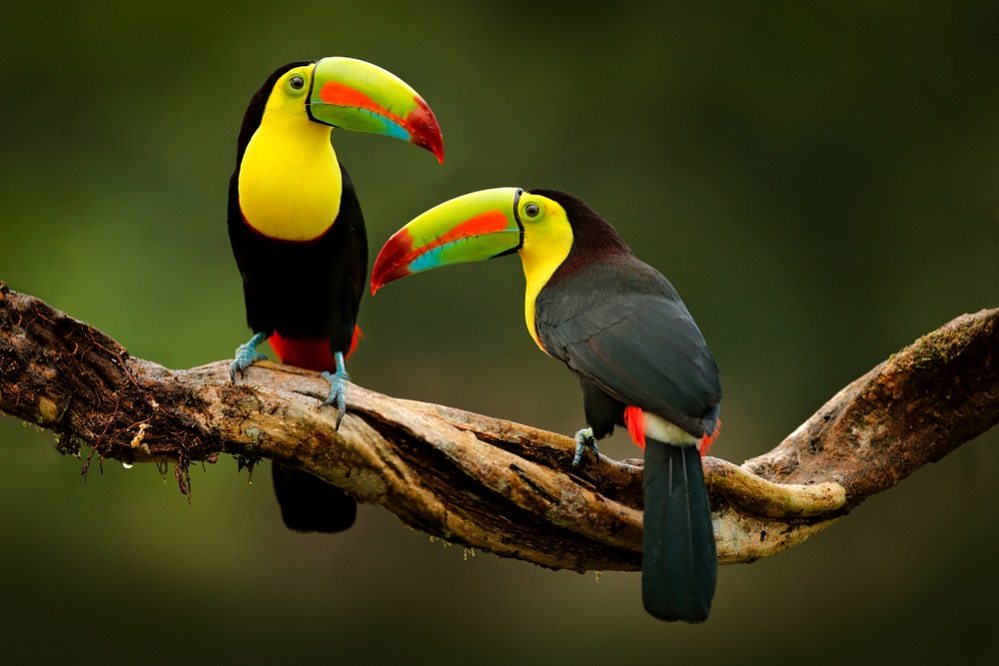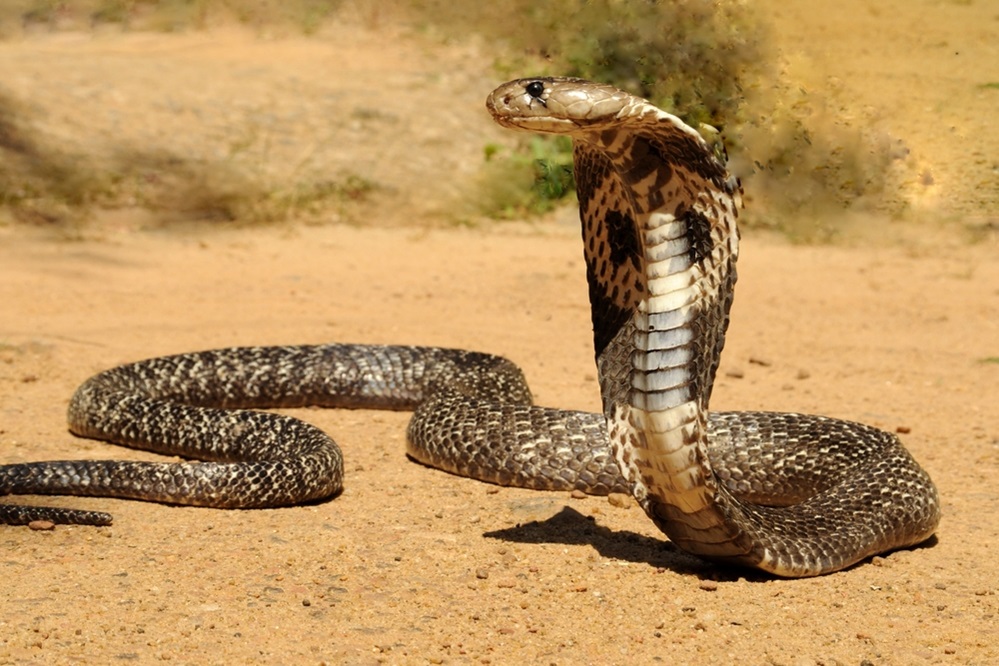The Toucan bird stands out for its striking appearance and charismatic presence, characterized by its oversized, colorful bill and lively nature. This exotic pet is cherished by many bird lovers and frequently featured in films and advertisements.
A Toucan’s bill can measure up to half of its body length. Unlike parrots, Toucans have several advantages as pets; they typically don’t bite as hard or chew furniture. They are friendly entertainers that can be taught various tricks.
Toucans are not only iconic symbols of tropical forests but also fascinating creatures deserving of admiration and study.

Types of Toucan
Table of Contents
Toucans are part of the family Ramphastidae, which comprises five genera and around 40 different species. Here is a breif overview of some of the well-recognized toucan species:

Wagler’s Toucan (Aulacorhynchus wagleri)
- Found in the mountainous regions of Central America and northern South America.
- Characterized by its vibrant green plumage, red throat, and yellow markings on its face.
- Named after the German herpetologist Johann Georg Wagler.
Groove-Billed Toucanet (Aulacorhynchus sulcatus)

- Found in the humid forests of Central and South America.
- Features a distinctive grooved bill and green plumage with yellow accents.
- Typically observed in pairs or small groups feeding on fruits and small vertebrates.
Tepui Toucanet (Aulacorhynchus whitelianus)
- Endemic to the tepui plateaus of southern Venezuela and adjacent areas of Brazil and Guyana.
- Recognized by its green plumage, yellow throat, and red undertail coverts.
- Prefers montane forests and is often found in small flocks or pairs.
Blue-Banded Toucanet (Aulacorhynchus coeruleicinctis)

- Found in the montane forests of western Venezuela and Colombia.
- Features a blue band across its chest and a red throat patch.
Black-Throated Toucanet (Aulacorhynchus atrogularis)
- Located within the cloud forests of the Andes in South America.
- Features a black throat patch, green plumage, and a bright yellow breast.
- Typically seen in small groups or pairs foraging for fruits and small prey.
Emerald Toucanet (Aulacorhynchus prasinus)
- Commonly found in montane forests from Mexico to northern South America.
- Small toucan with predominantly green plumage and a yellow chest.
- Often spotted in small flocks feeding on fruits and insects.
Crimson-Rumped Toucanet (Aulacorhynchus haematopygus)

- Endemic to the Andean cloud forests of Ecuador and Peru.
- Recognized by its crimson-red rump and green plumage.
- Prefers high-altitude habitats and is often found in mixed-species flocks.
Chestnut-Tipped Toucanet (Aulacorhynchus derbianus)
- Endemic to the Andean cloud forests of northern South America.
- Named for the chestnut-colored tips of its tail feathers.
- Often seen in mixed-species flocks and is an important seed disperser in its ecosystem.
White-Throated Toucanet (Aulacorhynchus albivitta)

- Inhabits cloud forests from northern Venezuela to northern Bolivia.
- Identified by its white throat patch and green plumage.
- Forms small flocks and is an active frugivore, feeding on a variety of fruits.
Yellow-Browed Toucanet (Aulacorhynchus huallagae)
- Typically found in the cloud forests of central Peru.
- Named for its distinctive yellow eyebrow stripe.
- Typically observed in pairs or small groups feeding on fruits and insects.
Blue-Throated Toucanet (Aulacorhynchus caeruleogularis)
- Inhabits cloud forests and montane forests from Mexico to Honduras.
- Named for the vivid blue throat patch contrasting with its green plumage.
- Typically seen in pairs or small groups foraging in the canopy.
Toco Toucan (Ramphastos toco)

- Found predominantly in the tropical forests of South America.
- One of the largest and most famous species.
- Boasts a jet-black body, adorned with white plumage on its throat and breast.
- Bright orange-yellow bill, which can measure up to half of its body length.
- Diet primarily consists of fruits, but they are also known to consume insects, small reptiles, and bird eggs.
Keel-Billed Toucan (Ramphastos sulfuratus)
- Known for its vibrant, rainbow-colored bill.
- Inhabits the tropical forests from southern Mexico to northern South America.
Ariel Toucan (Ramphastos vitellinus ariel)
- Found in Brazil and Bolivia.
- Upper mandible and culmen has a yellow base.
- Orange-yellow uppertail coverts.
- White throat and breast.
Channel-Billed Toucan (Ramphastos vitellinus)

- Recognized by its broad bill with ridged edges.
- Inhabits the rainforests of South America.
Yellow-Throated Toucan (Ramphastos ambiguus)
- Found in the forests of Central and South America.
- Identified by its yellow throat and black plumage.
Choco Toucan (Ramphastos brevis)
Endemic to the Chocó-Darién region of western Colombia and northwestern Ecuador.
Features a shorter bill compared to other toucan species.
Green-Billed Toucan (Ramphastos dicolorus)

- Found in the Atlantic Forest of eastern Brazil and adjacent areas.
- Features a predominantly black body with a green bill.
Ivory-Billed Toucan (Pteroglossus azara)
- Found in the subtropical and tropical forests of South America.
- Identified by its ivory-colored bill and black plumage.
Curl-Crested Toucan (Pteroglossus beauharnaisii)
- Endemic to the Amazon Basin and adjacent areas.
- Recognized by its distinctive curled crest and colorful plumage.
Green Aracari (Pteroglossus viridis)
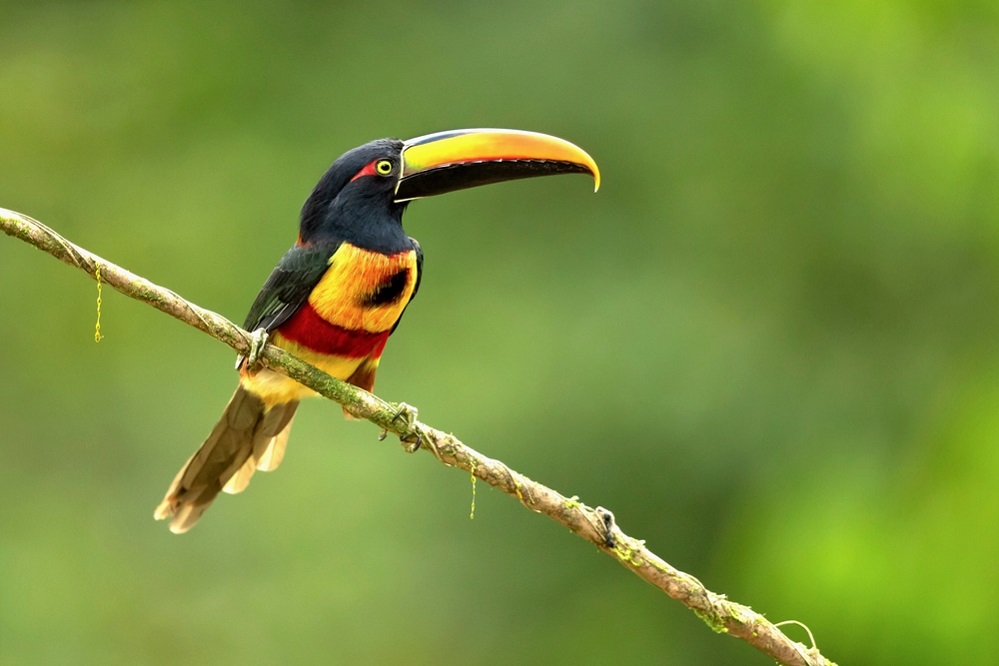
- Small toucan with predominantly green plumage.
- Found in the lowland forests of northern South America.
Collared Aracari (Pteroglossus torquatus)
- Inhabits the forests of Central and South America.
- Features a distinctive yellow collar around its neck.
Many-Banded Aracari (Pteroglossus pluricinctus)
- Endemic to the Amazon Basin and adjacent areas.
- Recognized by its colorful plumage and banded bill.
Stripe-Billed Aracari (Pteroglossus sanguineus)

- Inhabits the rainforests of South America.
- Named for the prominent black stripes on its bill.
Pale-Billed Aracari (Pteroglossus erythropygius)
- Found in the Amazon Basin and adjacent areas.
- Features a pale bill and vibrant plumage.
Chestnut-Eared Aracari (Pteroglossus castanotis)
- Endemic to the forests of northern South America.
- Identified by its chestnut-colored ear patches.
Fiery-Billed Aracari (Pteroglossus frantzii)

- Inhabits the humid forests of Central America.
- Recognized by its fiery-colored bill and black plumage.
Black-Necked Aracari (Pteroglossus aracari)
- Typically, found in the forests of northern South America.
- Named for the black band around its neck.
Western Red-Necked Aracari (Pteroglossus bitorquatus)
- Endemic to the forests of western South America.
- Features a red band around its neck and a colorful bill.
Red-Breasted Toucan

- Inhabits the Amazon Basin with a predominantly black body and a red breast patch.
- Plays a vital role in seed dispersal in its ecosystem.
Guianan Toucan
- Founds in the Guianan region of northeastern South America.
- Identified by its distinctive black-and-yellow bill and green plumage.
Plate-Billed Toucan
- Found in the mountainous regions of Central and South America.
- Characterized by its distinctive plate-like bill.
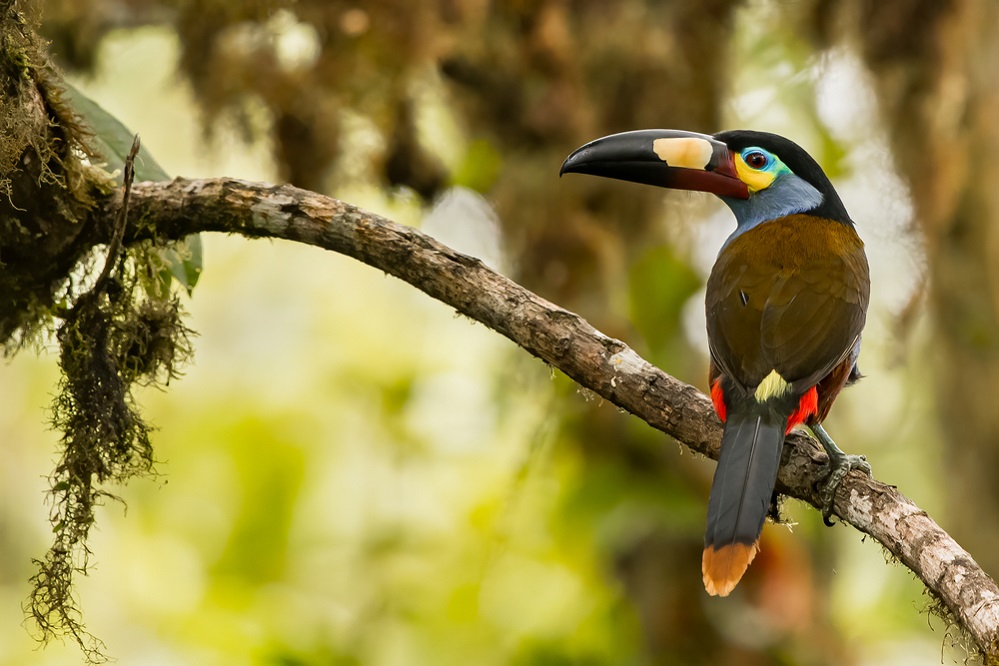
Lesser-Known Toucan Species
Below are several lesser-known toucan species that may not be widely recognized:
- Yellow-billed Toucanet
- Greyish-throated Toucanet
- Cuvier’s Toucan
- Citron-throated Toucan
- Yellow-ridged Toucan
- Saffron Toucan
- Humboldt’s Toucan
- Eastern Red-necked Toucan
- Lettered Toucan
- Spot-billed Toucan
- Yellow-eared Toucan
- Gould’s Toucan
- Tawny-tufted Toucan
- Grey-breasted Toucan
- Hooded Toucan
- Black-billed Toucan
Distribution and Habitat
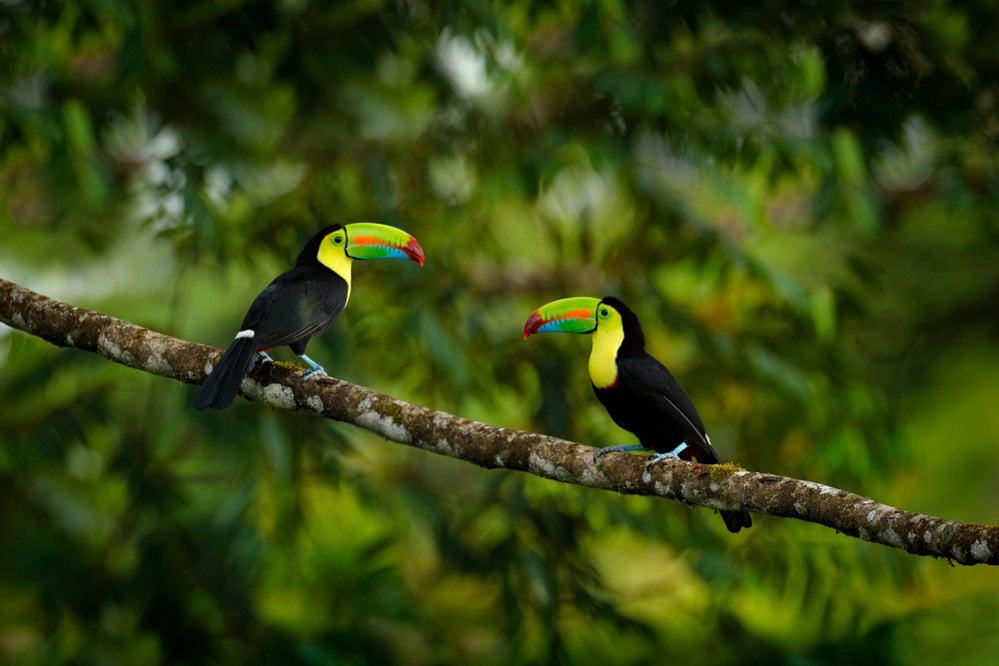
The toucan’s distribution and habitat encompass the tropical and subtropical regions of Central and South America, spanning diverse ecosystems from dense rainforests to montane forests and occasionally savannas.
These iconic birds are predominantly found in countries such as Brazil, Colombia, Peru, Ecuador, and Bolivia, with some species also inhabiting regions of Mexico, Central America, and northern Argentina.
They typically inhabit humid, lowland rainforests distinguished by dense vegetation and abundant fruit-bearing trees. Additionally, toucans are adaptable, thriving in various forest types including montane forests at higher elevations, where temperatures are cooler.
Toucans are known to inhabit cloud forests, gallery forests, and even disturbed or secondary growth forests. Some species prefer the canopy while others frequent the mid-story or lower levels of the forest.
Toucan's Nest
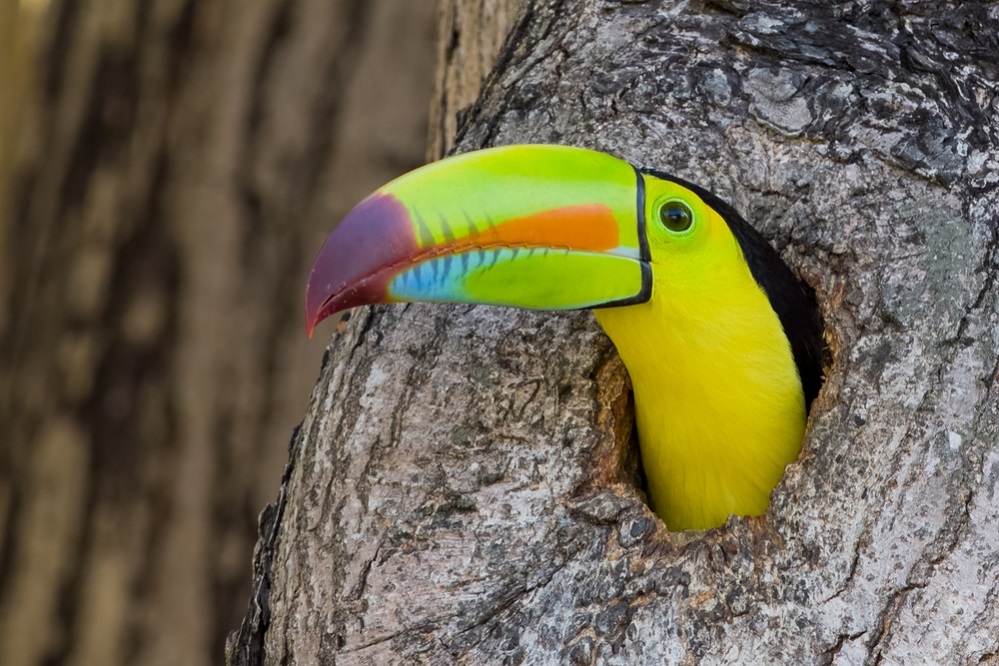
Toucans typically nest in tree cavities, utilizing natural hollows formed by decay or abandoned nests created by other cavity-nesting birds such as woodpeckers. They may also excavate their own nest cavities using their large bills, although this behavior is less common.
Toucans line their nests with soft materials such as leaves, feathers, and other plant matter to provide insulation and cushioning for their eggs and chicks. Larger species may require larger nest cavities to accommodate their size, while smaller species may utilize smaller cavities.
Toucans may exhibit communal nesting behavior, with several pairs occupying adjacent nest sites within the same tree or cluster of trees.
Toucan Appearance

The most iconic feature of toucans is their large, colorful bill. It is long, curved, and often brightly colored, ranging from hues of orange, yellow, red, green, and black. The bill is both lightweight and strong. Toucans have compact bodies with short legs and stout necks.
Their bodies are covered in soft, dense feathers. The plumage of toucans varies among species, with colors ranging from black to various shades of green, red, yellow, and white. Toucans have relatively large heads with expressive eyes and a short, rounded crest or tuft of feathers on top. Their eyes are typically dark in color and provide excellent vision.
Toucans have short, rounded tails that are often hidden beneath their plumage. While not as prominent as their bills, the tail feathers may also exhibit colorful patterns or markings depending on the species.
Toucans vary in size depending on the species, with some smaller species measuring around 12 inches in length and larger species reaching up to 25 inches or more. Despite their large bills, toucans are lightweight birds, with most species weighing between 4 to 12 ounces (110 to 340 grams).
Scientific Classification
14 Interesting Facts About Toucans
- Toucans’ bills are lightweight and primarily hollow in structure.
- Toucans produce distinctive vocalizations, including croaks, barks, and yelps.
- Toucans exhibit social behavior, often forming small groups called “bands” or “parties” for roosting and foraging.
- The wingspan of toucans typically ranges from 43 to 60 inches

- The average estimated lifespan of toucans in the wild ranges from 12 to 15 years, while those in captivity can live for over 20 years.
- There are approximately 40 species of toucans, varying in size, coloration, and habitat preferences.
- The incubation period for toucan eggs lasts approximately 17 to 18 days.
- Toucans typically lay clutches of around three eggs on average.
- Toucans begin molting at around one year of age.
- Toucans can reach top flying speeds of up to 40 mph.
- According to a-z animals, the frog-like squawk of a toucan can be audible from a distance of one mile.
- Toucans are not known for graceful flight; they are considered poor fliers.
- Hollow trees can accommodate groups of five or six toucans huddling together.
- Toucans produce a variety of vocalizations, displaying a wide range of sounds and calls.
Toucan Diet

Toucans are primarily frugivorous birds, meaning their diet mainly consists of fruits. They have a particular preference for a wide variety of fruits, including figs, berries, and palm fruits. Their large, colorful bills are perfectly adapted for plucking and consuming these fruits from trees.
In addition to fruits, toucans also supplement their diet with insects, small reptiles, and bird eggs, especially during the breeding season when protein-rich foods are essential for raising their young.
Breeding and Life Cycle

Breeding pairs of toucans engage in intricate courtship rituals, which may involve mutual bill-touching, vocalizations, and aerial displays. Toucan females typically lay clutches of two to four eggs, with clutch size varying among species.
The eggs are incubated by both parents for around two to three weeks until they hatch. Both male and female toucans take turns incubating the eggs and feeding the chicks once they hatch. Toucan chicks remain in the nest for several weeks after hatching, during which time they are cared for by their parents.
Once baby toucans are fully feathered and capable of flight, the chicks fledge from the nest and begin to explore their surroundings under the watchful eyes of their parents.
In some toucan species, cooperative breeding occurs, where non-breeding individuals help raise the offspring of breeding pairs. These helpers may assist with nest-building, incubation, and feeding, contributing to the overall success of the breeding pair.

The timing of toucan breeding varies among species and is often influenced by seasonal changes. In general, breeding occurs during the dry season when resources are abundant, providing optimal conditions for raising young.
Toucan Predators
Toucans face a variety of predators throughout their range in Central and South America. Raptors such as hawks, eagles, and owls may prey on toucans, particularly juveniles or smaller species. Arboreal snakes such as tree boas and tree pythons are known to climb trees to hunt for birds, including toucans. Mammals like ocelots, margays, and coatis may prey on toucans, especially when they are nesting or roosting in trees.
Threats To Toucans

Toucans face several threats to their survival, primarily stemming from human activities and habitat loss. Deforestation and habitat degradation are significant threats to toucans, as they rely on diverse forest ecosystems for food, nesting sites, and shelter.
Clearing of forests for agriculture, logging, urbanization, and infrastructure development leads to the loss of critical habitat for toucans and disrupts their ecological balance. Toucans are often targeted for the illegal pet trade due to their vibrant plumage and unique appearance.
Capture and trafficking of toucans for the exotic pet market result in population declines. In some regions, toucans are hunted for their feathers, meat, or perceived medicinal properties.
Agricultural pesticides and pollution from human activities can contaminate toucans’ food sources and water, leading to health issues and reproductive problems. Exposure to toxic chemicals can weaken toucans’ immune systems and reduce their reproductive success.
Conservation Status

The total population of wild toucans remains uncertain, but estimates suggest that there are more than 10,000 mature individuals. These iconic birds are classified as “least concern” by the International Union for Conservation of Nature (IUCN) due to their extensive geographic range.
However, according to the IUCN Red List, three toucan species are categorized as endangered, while five toucan species are listed as near threatened. Unfortunately, despite their classification, overall toucan populations are experiencing a decline.
FAQs
How many species of toucans are there?
There are more than 40 species of toucans.
Why do toucans have large bills?
Toucans’ bills are adapted for feeding on fruits and for regulating body temperature.
Do toucans make good pets?
Toucans have specialized care requirements and are not suitable as pets for most people.
Do toucans migrate?
Toucans are generally non-migratory birds, but some species may make seasonal movements within their range.
How long do toucan eggs take to hatch?
Toucan eggs have an incubation period of approximately 17 to 18 days.
Are toucans noisy?
Yes, toucans are known for their vocalizations, which include various calls and squawks.
Can toucans mimic human speech?
Toucans are not known for mimicking human speech like some other birds such as African Gray parrot or Macaws.
Is it legal to own a toucan in US as pet?
Owning a toucan as a pet in the United States varies by state and locality. Legal requirements, permits, and regulations apply. Research thoroughly before acquiring one.
What is the most widely recognized toucan species?
The most widely recognized toucan species are the Toco Toucan and Keel-billed Toucan, known for its vibrant colors and large, rainbow-colored bill.
Are Toucans herbivores, carnivores, or omnivores?
Toucans are omnivorous, consuming both plant matter and other animals in their diet.
What is the price of Toucan in the United States?
Toucans typically start at a price of $10,000.
Final Words
While toucans may exhibit playful and affectionate behavior, it’s crucial to remember that they are wild animals best suited to their natural habitats. Despite their captivating charm and potential as pets, toucans retain their innate instincts and specialized needs acquired from living in the wild.
Toucans thrive in the complex ecosystems of tropical forests, where they play essential roles as seed dispersers and contributors to ecosystem balance. Attempting to keep toucans as pets can pose significant challenges, as meeting their dietary, social, and environmental requirements in captivity can be demanding and expensive.
However, like many other species of wildlife, Toucans face numerous threats in the modern world, highlighting the urgent need for conservation action to protect their natural habitats and ensure their continued survival.
While toucans may captivate with their charm and intelligence, respecting their wild nature and preserving their natural habitats remain paramount for their well-being and conservation.

